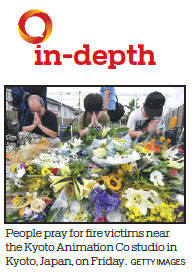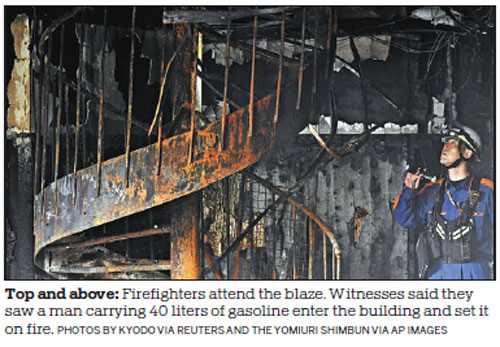KILLER BLAZE STRIKES AT PILLAR OF ANIME INDUSTRY
Communication, education and full-time jobs emphasized at Kyoto studio
It took Japanese company Kyoto Animation almost 40 years to establish itself as one of the leading production studios in the anime industry.
But within hours on Thursday, an arson attack at its Kyoto studio had killed dozens of the company's employees and destroyed much of the materials for past and current projects.
Thirty-four people died after a man stormed into the studio's main building and set it ablaze in the morning, officials said. Around 35 others were injured, about 10 critically.
The next day, police named 41-year-old Shinji Aoba as the suspect.
Authorities said witnesses reported seeing Aoba burst into the building at about 10:35 am on Thursday, carrying 40 liters of gasoline and a bag of hammers and knives, and start the fire.
Keiyu Hada, a high school student, told The Guardian he was walking past the studio with his mother when he saw that it was ablaze.
"We were about 10 meters away, but the heat was so intense on my face that it was unbearable. I saw three people outside who had come out of the building. They were on fire - their clothes and hair were burning," said the student, whose family looks after and lives at a local Buddhist temple.
Japanese public broadcaster NHK quoted one employee, who was inside the studio at the time of the attack and spoke on the condition of anonymity, as saying he saw smoke everywhere and heard people shouting that there was a fire.

"I couldn't see anything. It was as if somebody had splashed black ink or paint all over the place. The smell was terrible. I felt that even taking one breath might kill me," the employee said.
He ran to a balcony on the second floor. "I felt a blast of hot air. I couldn't bear it anymore. I had to choose between jumping and getting hurt or letting the smoke kill me. It was a choice between life or death," he said. The employee jumped from the balcony, landing safely.
The death toll from the attack was the highest in Japan for such an incident since 2001, when a blaze in Tokyo's Kabukicho district killed 44 people.
NHK reported that Aoba, the named suspect, had served time in prison for robbery and that he was being treated for an unspecified mental illness. The report, which cited an unidentified source, said he told police he started the fire because Kyoto Animation had "copied his ideas and stolen from his novel".
The studio had received a string of threatening emails before the attack, the report said.
Kyoto Animation's founder and CEO, Hideaki Hatta, told the media on Friday: "There are people who criticize anime works, just as there are those who support them. When there are threats, we consult with the police, but I have no idea what led to this incident."
The blaze struck at a pillar of Japan's anime industry, which is a national obsession and a main cultural export. Kyoto Animation, known by fans as KyoAni, has produced many animation hits and won worldwide acclaim for its skilled drawings.
The hours after the attack saw an outpouring of anger, grief and confusion both in Japan and overseas.
Outside the charred shell of the company's premises on Kyoto's outskirts, crowds of well-wishers left flowers and messages of support for the victims. Many bowed or knelt and prayed as they paid their respects.
A female animation fan told Kyodo News: "I was really quiet in high school, but thanks to Kyoto Animation, I was able to make friends. I owe them so much."
Chinese student Ou Shouming, 23, who is studying Japanese in Tokyo, traveled to Kyoto by bullet train to pay his respects.
"Kyoto Animation's productions are very popular in China - I have known them since I was in junior high school. They make anime and stories that touch your heart," he said, adding that news of the attack was the top trending item on Sina Weibo.
"I can't understand why someone would do this. I want to hear the reason from the criminal," Ou said.
After news of the attack broke, a campaign was launched on the online fundraising platform GoFundMe, raising nearly $100,000 in two hours. To date, the total stands at $1.90 million.
The campaign was started by Sentai Filmworks, which distributes Japanese cultural works in the United States. Most fans donated $50 or less.

Donor Darrian Harrison wrote: "This company produced so much anime that helped shape me ... most of them were absolute masterpieces."
L. C. Mendoza, another donor, said, "KyoAni's works have been a part of my childhood."
Fellow donor Mackenzie Haa said: "Kyoto Animation is a model for the anime industry and deserves so much better than this. I hope they come back stronger than ever after this tragedy".
Tributes to the victims poured in on social media. The hashtag#PrayforKyoAni has become popular.
Many netizens shared their favorite shows, and told how they had been shaped by them over the years. Most of the tributes voicing concern referred to staff members who may have lost their lives and their families.
But fans also lamented the potential artistic loss.
One Twitter user wrote, "Thousands of drawings, computers with important animation files ... whatever they currently have in the pipeline may have been very nearly or completely destroyed." Other users said the studio must have backups.
Xie Bing, 25, a Chinese student at Kyoto University, said she could not forgive the perpetrator.
"The young people at Kyoto Animation were beautiful and warm, and it is hard to accept they are gone," she said.
In a statement in Japanese, the Chinese embassy in Japan expressed condolences to those who lost their lives and sympathy for the injured. Messages of support for the studio were posted below the statement.
Founded in 1981 by animator Yoko Hatta and her husband, Hideaki, Kyoto Animation was a different kind of studio from the very beginning.
For one thing, it is 365 kilometers from Tokyo, where the vast majority of Japan's anime production houses are located.
According to a survey in 2016 by the Association of Japanese Animations, 542 of the 622 anime production companies operating in Japan, or 87 percent, are in Tokyo. The fact that KyoAni is a considerable distance from the Japanese capital is thought to represent a deeper philosophical divide in terms of the company's business practices.
Moreover, most studios in Japan employ animators on a freelance basis, a practice that has created "unlivable wages" and overwork for many in the industry, especially young people.
But by the early 1990s, Kyoto Animation had developed a culture that emphasized communication, education and full-time employment. The studio's in-house KyoAni School spent a large amount of time training young recruits, a significant percentage of them women.
"It's one of the best and largest animation firms in Japan," Tokyo film commentator Yuichi Maeda told Reuters. "With that loss of life, many of the best hands at animation in the nation are likely to be dead."
He said the studio's impact on the industry was much greater than the limited number of works it made would suggest, adding: "It's too painful to contemplate. It has a huge presence in animation here. To have this many people die at the same time will be a huge blow to the Japanese animation industry."
According to the Japanese newspaper Mainichi Shimbun, Kyoto Animation's success was bolstered by the company's structure. "The numerous detailed and disparate elements of anime production were completed under its own roof, enabling the studio to maintain a high standard of work," the paper said.
But the fact that many staff members were working at the same location played a large part in the loss of so many lives on Thursday, the newspaper said.
According to a private sector credit research company quoted by Japanese media organization Nikkei, Kyoto Animation employs about 150 people. Those who died in the arson attack comprised 20 percent of the staff members.
Katsuyoshi Yatabe, an anime director and professor at Osaka University of Arts, said that in the Japanese anime industry, where a great deal of labor is required for just one title, works are normally produced by a group of different companies working separately on elements of the creative process.
However, at Kyoto Animation, almost the entire process is completed in a "collective way" - from the detailed coloring of animated frames to the composition of backgrounds and the creation of footage, the professor said.
"To proceed with various parts of a project simultaneously, the number of people required for that purpose in the building would usually be high," Yatabe added.
Despite its geographical and "philosophical" distance from Tokyo, Kyoto Animation has been influential in the anime industry as a whole. The studio's highly original works have earned it fans at home and abroad, and peers in the industry have praised its titles as having an "idiosyncratic Kyoani quality".
Its early hits such as The Melancholy of Haruhi Suzumiya, Lucky Star and K-On! - all adaptations of novels and manga - were helmed by its in-house directors such as Naoko Yamada, who joined Kyoto Animation from university and made her directorial debut at age 24.
Early this decade, the studio launched the KyoAni Awards, for which aspiring writers submit their novels, with the winning titles adapted into anime, according to Japan Times. Several of the studio's recent productions, including Free! and Violet Evergarden, are products of this system.
As of last week, the studio was working on follow-ups to these two productions, along with a new series based on the latest KyoAni Award-winning novel.
"But all the materials for these works have been destroyed in the fire", Hideaki Hatta said.
"The victims were all excellent colleagues, and the attack is a serious blow to our company and the industry. I don't know how long it will take for us to recover," he added.
panmengqi@chinadaily.com.cn
|
From left: People pray for the victims and leave tributes in Chinese near the Kyoto Animation studio after Thursday's arson attack, which left more than 30 employees dead. Photos By Kyodo News Via Getty Images, Kim Kyunghoon/ Reuters And The Yomiuri Shimbun Via Ap Images |


(China Daily Global 07/23/2019 page1)



















